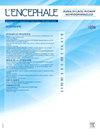关于 sHLA-E 对精神分裂症和双相情感障碍影响的重复研究。
IF 1
4区 医学
Q4 NEUROSCIENCES
Encephale-Revue De Psychiatrie Clinique Biologique et Therapeutique
Pub Date : 2025-06-01
DOI:10.1016/j.encep.2024.04.004
引用次数: 0
摘要
目的:精神分裂症(SZ)和双相情感障碍(BP)是慢性严重神经精神疾病。这些疾病与免疫失调密切相关。在目前的研究中,我们打算在突尼斯的一个人群中重复之前报道的可溶性 HLA-E 同工酶(sHLA-E)与这两种疾病的发病风险和疾病严重程度有关的情况:本病例对照研究纳入了符合 DSM-IV 标准的 124 名精神分裂症患者和 121 名躁郁症患者,以及 111 名健康对照者。采用酶联免疫吸附法测定了可溶性 HLA-E 同工酶的循环水平。统计分析采用 R 软件和 GraphPad prism 9 的 Kruskal-Wallis 和 Wilcoxon 秩和检验:结果:我们发现,与健康对照组相比,血压患者的 sHLA-E 循环水平明显较高:总之,本研究结果在突尼斯人群中复制了之前在法国患者队列中证实的 sHLA-E 循环水平对 BP 或 SZ 患病风险的影响。因此,在这两种疾病的背景下,可以将 HLA-E 视为一种有效的、真正的炎症标志物。本文章由计算机程序翻译,如有差异,请以英文原文为准。
A replication study of sHLA-E influence on schizophrenia and bipolar disorder
Objectives
Schizophrenia (SZ) and bipolar disorders (BP) are chronic and severe neuropsychiatric diseases. These disorders are tightly related to immune deregulations. In the current study, we intended to replicate the previously reported involvement of the soluble HLA-E isoforms (sHLA-E) in the risk of developing the two conditions along with disease severity in a Tunisian population group.
Patients and methods
One hundred and twenty-four patients with schizophrenia and 121 with bipolar disorder meeting the DSM-IV criteria along 111 healthy controls were included in this present case-control study. The soluble HLA-E isoforms circulating levels were measured using the ELISA method. The statistical analyses were performed using Kruskal-Wallis and Wilcoxon rank sum tests by R software and GraphPad prism 9.
Results
We found that the sHLA-E circulating levels were significantly higher in BP patients as compared to healthy controls (P < 0.0001) and that such increases were mainly observed in patients during an acute phase of their disease (P < 0.0001). In SZ patients, while we failed to observe an association with the levels of sHLA-E in the entire SZ sample, we found that high sHLA-E levels characterized stabilized patients in comparison with those during an acute episode (P = 0.022). Finally, we did not observe any association between sHLA-E circulating levels and symptoms assessed by the classical clinical scales either in BP or SZ patients.
Conclusion
Overall, the present findings replicate in a Tunisian population group the previously demonstrated implication of sHLA-E circulating levels in the risk of developing BP or SZ in a French patient cohort. Such replication allows to consider HLA-E as a potent and true inflammatory marker in the context of the two disorders.
求助全文
通过发布文献求助,成功后即可免费获取论文全文。
去求助
来源期刊
CiteScore
4.60
自引率
7.40%
发文量
162
审稿时长
6-12 weeks
期刊介绍:
Une revue française de renommée internationale.
- Un comite de rédaction représentant tous les aspects de la prise en charge psychiatrique du patient.
- Une sélection rigoureuse d''articles faisant l''objet de plusieurs expertises.
- Des travaux d''auteurs et de chercheurs de renommée internationale.
- Des indexations dans les grandes bases de données (Current Contents, Excerpta Medica, etc.).
- Un facteur d''impact qui témoigne de la grande notoriété de la revue.
La tribune des publications originales de haut niveau.
- Une très grande diversité des sujets traités, rigoureusement sélectionnés à travers des sommaires dynamiques :
- des éditoriaux de médecins référents,
- une revue de presse sur les actualités internationales,
- des articles originaux pour approfondir vos connaissances,
- des mises au point et des cas cliniques pour engager votre réflexion sur les indications et choix possibles au travers de mises en situation clinique,
- des dossiers thématiques pour faire le tour d''une question.
- L''actualité de l''AFPB : L''Encéphale publie régulièrement des comptes rendus de l''Association française de psychiatrie clinique.

 求助内容:
求助内容: 应助结果提醒方式:
应助结果提醒方式:


